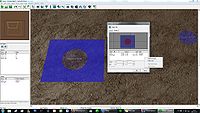Regions and Points
Regions and Points are extremely used when creating a map. They are used to reference to a region or a position (respectively) of the map.
Regions
Regions are used to define specific areas of a map and used in conjunction with triggers.
By entering a Region's properties, you gain access to the ability to rename it, give it a custom color, change its position, change its size, merge multiple regions, negate it, etc.
The menu on the left of GalaxyEdit also lets you decide if the Region should be displayed in the map's 3D visualization.
When creating new Regions, you can only draw circles or rectangulars.
Custom Shapes
In order to have a custom-shaped Region, you'll have to have create an initial Region, get into its properties, and manually add and set the position of the new Regions that will create the custom shape.
See the Image for reference.
Of course, there is an easier method: create all the Regions you want to merge, select them all, and press Num Pad 0 (or you can go into Edit > Merge Selection command).
Negative
Negative Regions are used to create holes into the custom-shaped Regions. In order to obtain one, simply check the little 'Negative' box shown in the Image.
Attached Regions
You can attach Regions to units with the trigger action named "Attach Region To Unit".
An attached Region will follow the unit is has been attached to. We can track this unit using the action named "Unit Attached To Region".
If the unit the Region is attached to dies, the Region is left where the unit died (TO BE CONFIRMED).
You can attach Regions to different units during the game.
Points
There are 4 types of Points: Normal, Start Location, Sound Emitter and Three Dimensional.
Unlike Regions, you can attach the Points to a unit directly from the Editor by entering its properties. You can also make the Point rotate, change its position, give it a custom color, change its name and make it a Model (?) from its properties.
Normal
That's a normal Point, there isn't much to say.
Start Location
Start Locations are used mainly for Melee maps as they aren't required for Custom maps. Anyhow, to assign placed Start Locations to Players, go to Player Properties.
Sound Emitter
You assign the sound that is emitted via the properties of this type of Point.
Three Dimensional
The properties of this type of Point let you determine the height (Z-axis value) of the Point.
Regions versus Points
There are many disadvantages and advantages to using Regions or Points. It all depends on the goal you wish to achieve.
Regions
With a region you can create a very complicated shape. This is done through selecting multiple regions, right clicking and selecting "Combine Regions".
Ideally you want to use regions in scenarios where a large area is considered to be one region. You can then have triggers firing when
- Unit is In Region = True
- Unit Enters/Leaves Region
Most commonly, a region can be translated into a Point. You can typically use 'Random Point in Region' or 'Center of Region'. This works well for creating or spawning new units in random locations.
Note: 'Random Point in Region' will select a random (x,y) value within the Region, and not select a Point you've created within it!
Points
Points are much more accurate. A circular region of Diameter 3, has millions of points within it.
Typically map-makers will use Points when creating specialized events or actions. For example, in the Campaign, all Nydus Worms were created through Ordering a Nydus Canal to use it's ability on a Point.
